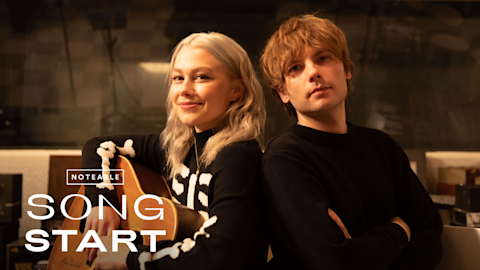Spotify data alchemist Glenn McDonald turns numbers into music experiences.
Ask Glenn McDonald what he does at Spotify, and a wry smile will appear. "My occupation, strangely, is called 'data alchemist,'" he says over a cup of coffee before a show in Boston—just over the river from Spotify's Somerville, Massachusetts, outpost. "I worry about anything at Spotify that takes in numbers on one end and tries to produce music experiences on the other—I try to make sure that the numbers make sense, and that the musical experience makes sense."
McDonald's work helps power the Related Artists tabs on individual artist pages, as well as Daily Mix—and that's not all. "I do a lot of strange projects on my own, looking for patterns and generating playlists," he says. "The website Every Noise at Once is the largest manifestation of that."
Every Noise at Once is a treat for anyone who likes to fall down online rabbit-holes of music: It's a massive map of (at this moment) 1,742 genres—umbrella genres like pop and country, as well as smaller niches like Thai hip-hop, German metal, and discofox—that McDonald has identified while examining the data that comes across his desk at Spotify. For music fans, it’s an endlessly fascinating look at how sound and aesthetics flow between regions and eras. For artists, it’s a useful source for understanding where they fit in the overall music universe, a context that can potentially be a valuable source of inspiration.
“It was originally a debugging tool,” says McDonald, who started working on Every Noise at Once when he was at the Echonest, a music intelligence company that Spotify acquired in 2014.
"We tried to use machine learning to evaluate subjective psychoacoustic attributes of songs—so how danceable, or energetic, or happy, or sad," he says. "It was very hard to tell how such a thing was working—you think, 'Does this song sound .7 happy?' But I found that if I aggregated those scores over genres, I could make sense of it."
Playing genres against each other let McDonald see how the machines were working, and how the styles of music related to one another; since then, it’s become the most public-facing aspect of McDonald’s work, inspiring a hoodie as well as the “most-appreciated genre” classification users get in Your Year In Music. “Some people get what they think are weird ones,” says McDonald, “but the fact that there's a cluster of listening means that the genre is a real thing, even though I might have made up the name.”
The main page of Every Noise at Once is a collage of words—that’s the list of genres, scatter-plotted out so that those on the lower part of the page represent more organic-sounding music, while the upper part of the page contains more mechanical styles; vintage classical singing is the furthest down on the page, while the electro niche re:techno is the highest. From left to right, music goes from dense and atmospheric to spiky and bouncy, with sound effects and dronescape hanging onto the left-hand margin and hard minimal techno staking out the right. Clicking the genre name triggers a sample of a representative track (from Spotify); hover over the genre name and a double arrow will appear, which takes users to genre pages.
Each genre page is taken up by a map of representative artists; clicking an artist’s name triggers another song sample, while clicking on the arrow takes the user to their Spotify page. Links to Spotify playlists with the genre's most representative songs head up the pages as well. "I spend a lot of time tweaking the rules," says McDonald. "I'll check the Intro to New Wave playlist and see, say, New Order—but the New Order song went from No. 1 to No. 3, and now it's 'Bring on the Dancing Horses,' and is that a better intro than 'Bizarre Love Triangle'?"
Some genres have links to "pulse" playlists, which list songs that aficionados might also be tuned into, and "edge" playlists, which collect artists that haven't broken through a certain popularity threshold; there are also some playlists that track 2017 songs appreciated by a genre's fans. When McDonald began Every Noise at Once, "my idea of 'a lot' of genres was 400," he laughs. The site now lists more than four times that and is constantly growing, with McDonald analyzing listening data over the years and every week to help him identify new musical ideas and directions taken by artists working within already-popular styles, which in turn helps make Spotify features like Daily Mix and Discover Weekly more in tune with users’ listening habits. Right now, he's on the lookout for three sets of patterns as he looks out for more genres to add to the site—and to Spotify’s musical IQ.
Functional music
"The boring-but-interesting one is functional music for one reason or another," says McDonald. "Sleep is the most obvious one, because there's been such a visible boom in white noise, and ocean sounds and stuff. But I recently realized there's a giant mass of music made for kids' ballet classes—simplified versions of classical music that kids can dance ballet to. There's a surprising amount of music supposedly designed to keep your pets calm while you're away. I'm always looking for those pragmatic subcultures, where people try to solve a problem in a way that uses music, but not in an expressive way."
New world musics
"Then there are new scenes particular to developing areas of the world, or areas of the world that are already developed, but that Spotify's just edging toward," says McDonald. "I'm fascinated by all this Fruity Loops-based experimental electronic music in Lisbon that's largely coming from Angola, where people have started catching up with technology on their phones and laptops. The tools get simpler, the technology gets cheaper, and there are all these people who had ways to make traditional music, but not cutting-edge music—or music that other people would recognize as cutting edge. It's the cultural crossover. It's become possible for people from far-flung areas to make music that crosses over into areas where the music industry is more mature. That Lisbon scene is really interesting, because it's a European capital, but it's mostly non-European producers."
Genres that don't have names yet
"The third set is things that don't quite have names yet, and maybe they're not exactly genres yet," says McDonald. "But I can name them and then I can watch them and see if they turn into a thing. One genre may not turn out to be a single 'thing'—it may be a bunch of things that will resolve into their own bits, and then the tentative genre will go away. But it's interesting to watch.
“Escape Room is a particularly in-jokey sort of name—it feels connected to trap sonically, although it's more experimental-indie-r'n'b-pop that spins off from the sonics of trap. I just thought about 'the trap,' and the idea of puzzle-solving in an escape room. PC Music [one Escape Room artist] sort of felt like it was solving and creating puzzles. Preverb is another one that I named; it's a play on 'reverb,' nodding to the acts' emerging nature."
McDonald’s close examination of music has resulted in him finding sometimes-amusing patterns across cultures. “Every culture has some guilty-pleasure thing that they think nobody else knows about, and they're all awesome,” he extols. “Schlager in Germany, chalga in Bulgaria and Serbia, tecnobrega in Brazil—seemingly everywhere, there's some terrible wedding music turned into dance-pop.” But it’s also allowed him to dig deeper into how styles of music come into fashion, identify new types of music making, and find out just how many cultures have refashioned popular genres to reflect their individual cultures. Every Noise at Once isn’t just fodder for endless listening parties; it’s a chance to examine and rethink the ways that music travels between cultures and between our ears.
-Maura Johnston
Popular Stories
video
How Julia Wolf Made It




